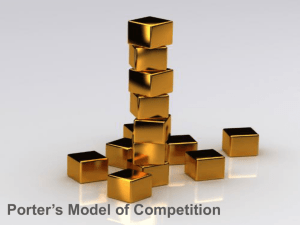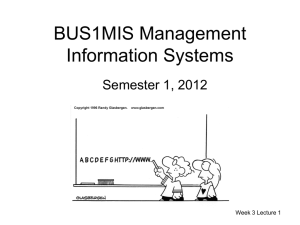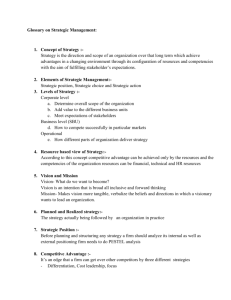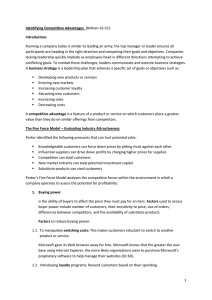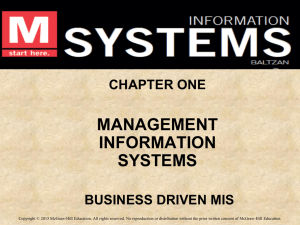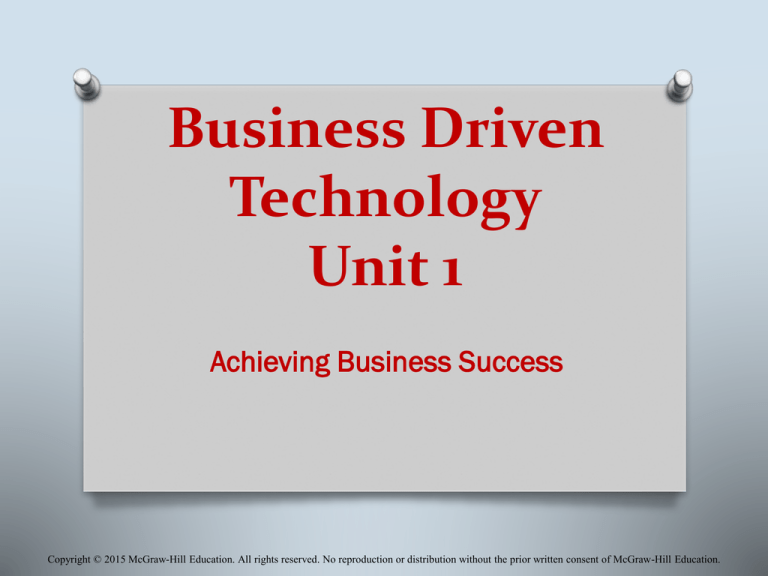
Business Driven
Technology
Unit 1
Achieving Business Success
Copyright © 2015 McGraw-Hill Education. All rights reserved. No reproduction or distribution without the prior written consent of McGraw-Hill Education.
Unit One
O Chapter 1– Business Driven Technology
O Chapter 2 – Identifying Competitive Advantages
O Chapter 3 – Strategic Initiatives for Implementing
Competitive Advantages
O Chapter 4 – Measuring the Success of Strategic
Initiatives
O Chapter 5– Organizational Structures that Support
Strategic Initiatives
2-2
Chapter 2
Identifying Competitive Advantages
2-3
LEARNING OUTCOMES
1. Explain why competitive advantages
are temporary
2. Describe Porter’s Five Forces Model
and explain each of the five forces
3. Compare Porter’s three generic
strategies
4. Demonstrate how a company can add
value by using Porter’s value chain
analysis
2-4
IDENTIFYING COMPETITIVE
ADVANTAGES
O Business strategy – A leadership plan that
achieves a specific set of goals or objectives
Developing new products or services
Entering new markets
Increasing customer loyalty
Attracting new customers
Increasing sales
2-5
IDENTIFYING COMPETITIVE
ADVANTAGES
2-6
IDENTIFYING COMPETITIVE
ADVANTAGES
O Competitive advantage – A product or
service that an organization’s
customers place a greater value on
than similar offerings from a
competitor
O First-mover advantage – Occurs when
an organization can significantly
impact its market share by being first
to market with a competitive
advantage
2-7
IDENTIFYING COMPETITIVE
ADVANTAGES
O Competitive intelligence –The process of
gathering information about the competitive
environment to improve the company’s ability to
succeed
O Competitive intelligence tools
O Porter’s Five Forces Model
O Porter’s Three Generic Strategies
O Porter’s Value Chain Analysis
2-8
THE FIVE FORCES MODEL
EVALUATING INDUSTRY ATTRACTIVENESS
2-9
Buyer Power
O Buyer power – The ability of buyers
to affect the price of an item
O Switching cost – Manipulating costs
that make customers reluctant to
switch to another product
O Loyalty program – Rewards customers
based on the amount of business they
do with a particular organization
2-10
Supplier Power
O Supplier power – The suppliers’ ability to
influence the prices they charge for supplies
O Supply chain – Consists of all parties involved in the
procurement of a product or raw material
2-11
Threat of Substitute
Products or Services
Threat of substitute products
or services – High when
there are many alternatives
to a product or service and
low when there are few
alternatives
2-12
Threat of New Entrants
O Threat of new entrants – High when it is easy
for new competitors to enter a market and low
when there are significant entry barriers
O Entry barrier – A feature of a product or service that
customers have come to expect and entering
competitors must offer the same for survival
2-13
Rivalry Among
Existing Competitors
O Rivalry among existing
competitors – High when
competition is fierce in a market
and low when competitors are
more complacent
O Product differentiation – Occurs when
a company develops unique
differences in its products or services
with the intent to influence demand
2-14
Analyzing the Airline Industry
O Perform a Porter’s Five Forces analysis of
each of the following for a company entering
the commercial airline industry
O Buyer power
O Supplier power
O Threat of substitute products/services
O Threat of new entrants
O Rivalry among competitors
2-15
THE THREE GENERIC STRATEGIES
CHOOSING A BUSINESS FOCUS
2-16
THE THREE GENERIC STRATEGIES
CHOOSING A BUSINESS FOCUS
2-17
VALUE CHAIN ANALYSIS
EXECUTING BUSINESS STRATEGIES
O Business process – A
standardized set of activities that
accomplish a specific task, such
as a specific process
O Value chain analysis – Views a
firm as a series of business
processes that each add value to
the product or service
2-18
VALUE CHAIN ANALYSIS –
EXECUTING BUSINESS STRATEGIES
O Primary value activities
O Inbound logistics - Acquires raw materials and resources, and
distributes
O Operations - Transforms raw materials or inputs into goods and
services
O Outbound logistics - Distributes goods and services to
customers
O Marketing and sales - Promotes, prices, and sells products to
customers
O Service - Provides customer support
2-19
VALUE CHAIN ANALYSIS
EXECUTING BUSINESS STRATEGIES
O Support value activities
O Firm infrastructure – Includes the company format or
departmental structures, environment, and systems
O Human resource management – Provides employee
training, hiring, and compensation
O Technology development – Applies MIS to processes to add
value
O Procurement – Purchases inputs such as raw materials,
resources, equipment, and supplies
2-20
VALUE CHAIN ANALYSIS –
EXECUTING BUSINESS STRATEGIES
2-21
VALUE CHAIN ANALYSIS –
EXECUTING BUSINESS STRATEGIES
2-22
LEARNING OUTCOME REVIEW
O Now that you have finished the
chapter please review the learning
outcomes in your text
2-23

